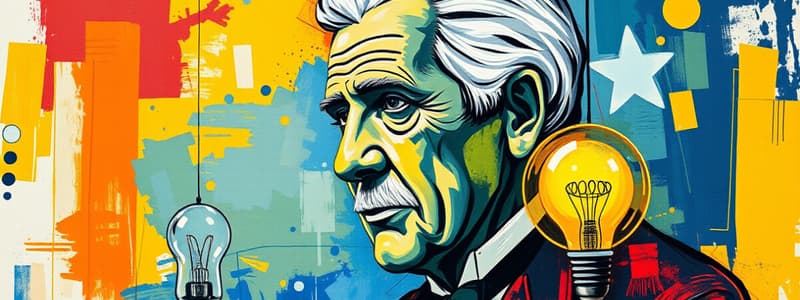Podcast
Questions and Answers
What was the main goal of William Dickson's assignment in Edison's lab?
What was the main goal of William Dickson's assignment in Edison's lab?
- To invent the light bulb
- To develop the phonograph
- To create a device that animated photographs (correct)
- To design the first industrial research lab
What did Edison hope the new device would accomplish for the eye?
What did Edison hope the new device would accomplish for the eye?
- Do for the eye what the phonograph does for the ear (correct)
- Create visual representations of music
- Improve the quality of photographs
- Provide entertainment through sound
Which device was NOT invented by William Dickson?
Which device was NOT invented by William Dickson?
- Phonograph (correct)
- Kinetoscope
- Motion picture camera
- Peep-show style device
What did Edison apply for at the US Patent Office?
What did Edison apply for at the US Patent Office?
What was the Kinetoscope intended to be?
What was the Kinetoscope intended to be?
Where was the world's first industrial research lab located?
Where was the world's first industrial research lab located?
Why did Edison hire assistants in his lab?
Why did Edison hire assistants in his lab?
What were audiences particularly eager for as film production began?
What were audiences particularly eager for as film production began?
What innovation did Edison and Dickson use to replace the less durable paper film?
What innovation did Edison and Dickson use to replace the less durable paper film?
What was the primary challenge Dickson faced when developing the film projection mechanism?
What was the primary challenge Dickson faced when developing the film projection mechanism?
How did Dickson initially adapt the film for motion pictures?
How did Dickson initially adapt the film for motion pictures?
What inspired Dickson's mechanism for stopping and moving the film?
What inspired Dickson's mechanism for stopping and moving the film?
What was the purpose of the kinetoscope that Edison unveiled?
What was the purpose of the kinetoscope that Edison unveiled?
What was Edison's view of motion pictures?
What was Edison's view of motion pictures?
Who collaborated with Edison to provide the necessary celluloid film for the kinetoscope?
Who collaborated with Edison to provide the necessary celluloid film for the kinetoscope?
What effect does the stop-and-go mechanism have on viewing film?
What effect does the stop-and-go mechanism have on viewing film?
Flashcards are hidden until you start studying
Study Notes
Thomas Alva Edison and Innovation
- Recognized as a pioneering inventor, Edison contributed significantly to various technologies but did not invent the light bulb or phonograph alone.
- Established the first industrial research lab at Menlo Park, New Jersey, employing skilled assistants to facilitate innovation.
W.K.L. Dickson’s Contributions
- W.K.L. Dickson was tasked with animating photographs, aiming to create moving images similar to how phonographs produce sound.
- Developed the first motion picture camera and a peep-show style device, marking the birth of film production.
Kinetoscope Invention
- Edison filed preliminary patent claims for a coin-operated entertainment device called the "Kinetoscope," intended to pair images with audio from a phonograph.
- Aimed for the Kinetoscope to provide a unique viewing experience resembling an interactive movie theater.
Technical Challenges and Innovations
- Initial challenges included creating a camera to capture images and developing a durable film medium.
- Inspiration was drawn from Etienne-Jules Marey's chronophotographic gun, leading to the adaptation of this technology for motion capture.
Film Technology Development
- Dickson discovered that celluloid filmstrips coated in light-sensitive emulsion worked effectively for continuous playback, a standard still used today.
- Collaborated with George Eastman to produce celluloid film in 50 ft rolls, supplying the necessary materials for film production.
Film Projection Mechanism
- Developed a mechanism to intermittently stop and hold the film for exposure, enabling a clear sequence of images to be captured and projected.
- Introduced "sprocket holes" along film edges, facilitating the advancement of film during the projection process.
Kinetoscope Prototype Presentation
- In 1881, Edison revealed the Kinetoscope prototype at the National Federation of Women's Clubs in New York City, providing the first opportunity for public film viewing.
- The Kinetoscope, designed as a cabinet with a peep hole, enabled individuals to watch moving images, distinguishing it as an early film exhibition device.
Limitations of Edison’s Vision
- Edison's initial perspective limited motion pictures to be complementary to phonographs rather than seeing their standalone potential.
Studying That Suits You
Use AI to generate personalized quizzes and flashcards to suit your learning preferences.




